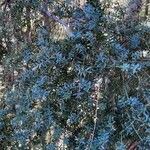Tree up to 30 m., trunk up to 2 m. diam., bark thick, stringy, furrowed. Lvs brownish to dark green; of juveniles c. 2 cm. × 1-2 mm.; of adults 1·5-3 cm. × 3-4 mm., linear-lanceolate, straight to slightly falcate, acute, pungent, coriac., patent, sessile by narrow base, midvein distinct or obscure. Male strobili 1-1·5 cm. long, solitary or up to 4 together on short peduncle, surrounded by broad rigid scales; apiculus small, obtuse, sparingly denticulate. Female branchlets axillary, ovules solitary or paired, peduncle 2-3 mm. long; receptacle of 2-4 scales, acute and free at tips, us. red, swollen and succulent, occ. dry. Seed subglobose when mature, or ovoid-oblong, 3-5 mm. long, nutlike.


